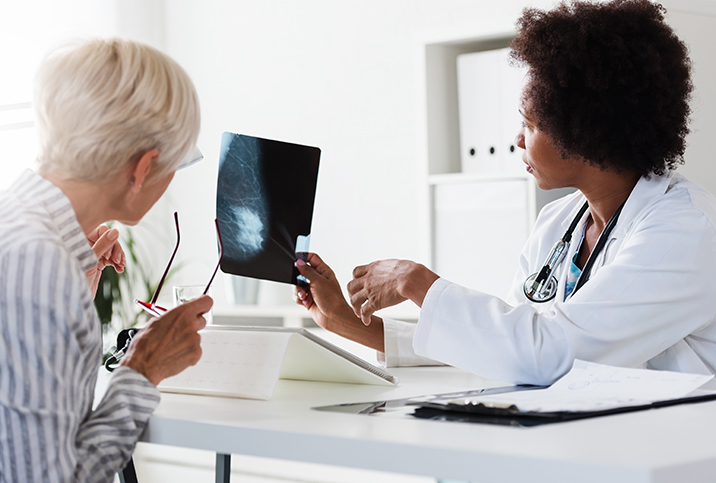Could a Wearable Device Help Prevent Metastatic Breast Cancer?

Key Points:
- Breast cancer is the second-leading cause of cancer deaths among women in the United States.
- Stage 1 and stage 2 breast cancer are highly treatable, but prognoses are much less favorable when the disease advances.
- Ultrasounds are crucial to detect breast cancer early, but it can be difficult for many people to access routine mammograms, and some develop cancer between regular screenings.
A new device could allow people at high risk of breast cancer to detect the disease early from the comfort of home.
Researchers have developed an affordable, wearable ultrasound device that could empower people to discover early signs of breast cancer without visiting a clinic or doctor's office. The device is three to five years away from being widely available—diagnostics and data collection need to be improved—but it represents a positive development in the breast cancer space.
What percentage of breast biopsies are cancer?
More than 300,000 people in the United States will be diagnosed with metastatic breast cancer in 2023, according to the American Society of Clinical Oncology (ASCO). Metastatic cancer is also known as invasive or advanced breast cancer. For about 6 percent of women in the U.S. diagnosed with breast cancer, this is the diagnosis when the disease is first detected.
More than 1 million people in the U.S. have breast biopsies every year, according to Cleveland Clinic. About 20 percent of those lead to a cancer diagnosis. Doctors use screenings, most commonly mammograms, to determine if a biopsy is needed.
What's the survival rate for stage 2 breast cancer?
Stage 1 and stage 2 breast cancer are characterized by tumors that haven't spread beyond the breast or immediate area (such as the breast skin, chest wall or nearby lymph nodes), according to the Susan G. Komen organization.
Most breast cancers are diagnosed in these stages in the U.S., which is best because the five-year relative survival rate is up to 99 percent.
The average five-year survival rate drops to about 30 percent when cancer is diagnosed at stage 4. Also known as metastatic breast cancer, stage 4 cancer is characterized by a tumor that has spread to distant parts of the body, such as the bones, liver or lungs.
Some forms of breast cancer are more likely to grow rapidly or metastasize than others, such as interval cancers that develop between routine mammograms.
"The data shows that interval-detected breast cancers are more likely to have spread and more likely to be a type that grows rapidly, both of which make the cancer more threatening," said Jennifer Tseng, M.D., the medical director of the division of breast surgery at City of Hope Orange County in Irvine, California.
Get breast cancer facts you can trust
- What to Expect at Your First Mammogram: Knowing what to expect during a routine mammogram screening can ease first-timers' stress.
- Breast Procedures—Myths & Misconceptions: Any breast procedure can be intimidating, so let's start by separating fact from fiction.
- How Fast Does Breast Cancer Spread?: It could be months, or it could be years, so here's a rough idea of what you might expect.
How could the wearable device help prevent metastatic breast cancer?
Mammograms are highly effective and detect about 87 percent of cancers, according to a 2016 study published in the journal Radiology.
However, patients currently need to visit an imaging center to receive a mammogram. That can present a significant barrier for many people, particularly those with limited incomes who may have difficulty securing funds, childcare or time off from work, Tseng said.
The stigma around breast cancer can cause women to neglect symptoms. Cultural factors, such as language differences or unfamiliarity with Western medical practices, can make some patients reluctant to seek care.
As a result, many women in the U.S. and worldwide miss or delay potentially lifesaving screenings.
The novel device would eliminate some of these barriers and give women a user-friendly, inexpensive and convenient way to regularly scan their breasts without leaving home, wrote the authors of the 2023 study, published in Scientific Advances.
'Cancers can develop between routine mammograms and not every unusual mass can be felt or seen.'
"The breast cancer community must keep working to help at-risk patients transcend these barriers and receive the screenings, treatment and support they need," Tseng said. "If breast cancer is suspected, precise breast cancer tests are crucial for treatment planning."
Additionally, some demographics are more at risk of interval cancers, which account for about 20 percent to 30 percent of all breast cancer diagnoses and could benefit from more frequent screenings.
Canan Dagdeviren, Ph.D., is an associate professor of media arts and sciences at the Massachusetts Institute of Technology (MIT) in Cambridge and the senior author of the paper. Her aunt, Fatma Caliskanoglu, was a breast cancer patient. She received regular mammograms but was diagnosed with late-stage breast cancer at age 49 and died six months later.
Her aunt's death inspired Dagdeviren to come up with the idea for the novel diagnostic device.
How does the wearable device compare to a mammogram?
The device, a flexible honeycomb patch with a 1-D ultrasound array and tracker, fits within a soft bra. Openings in the bra enable the device to touch the skin as the wearer moves the tracker to examine breast tissue from six different positions and various angles. The device sends sound waves into the breast tissue and produces images for evaluation by a breast cancer specialist.
The researchers tested the device on a 71-year-old woman with a history of breast abnormalities. The device detected a small cyst, 0.3 centimeters (cm) in diameter, in her right breast and a 1 cm cyst in her left breast. Their results were confirmed by an ultrasound specialist whose findings were the same.
Accessibility isn't the patch's only advantage over conventional scans, Dagdeviren said in an email interview.
Handheld ultrasonography (HHUS), the preferred method of breast imaging along with an automated breast ultrasound (ABUS), relies heavily on a technician's expertise and training to manually scan the whole breast by applying strong compression.
ABUS can scan the entire breast at once but still has subpar skin contact because of the liquid medium between the breast tissue and stationary, bulky machines.
"This device is a first-of-its-kind ultrasound technology with a nature-inspired design, which offers noninvasive, large field-of-view, real-time, user-friendly and continuous monitoring of curved breast tissue in a wearable form factor," Dagdeviren said.
The device overcomes the gaps of a required technician's expertise and the lack of necessary skin contact in an ABUS.
"[This] could not only help doctors reliably assess breast imaging but also provide a cost-effective, accessible and user-friendly approach for early assessments of breast anomalies," Dagdeviren said.
It would provide a fundamental shift in clinicians' and patients' ability to screen for, detect and diagnose breast cancer. This is a significant development, as early detection is critical for a high chance of survival, Dagdeviren said.
The bottom line
This novel device is a stride against breast cancer, along with other innovations such as 3-D mammography, nipple-sparing mastectomies, and high-precision radiation and immunotherapies, Tseng said.
"Prevention and early detection of breast cancer can involve a variety of screening techniques, and the more options available to patients and physicians, the better," Tseng said. "Breast cancers can develop between routine mammograms and not every unusual mass can be felt or seen, so this type of device could be a useful supplement for self-exams performed at home."


















